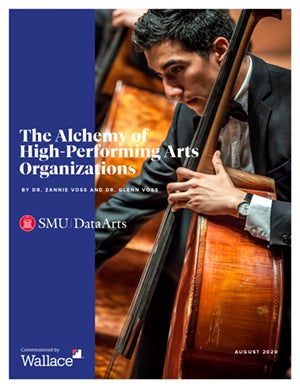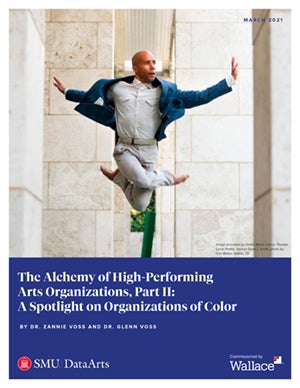What makes an arts organization thrive financially? How can a struggling organization turn its fortunes around? Two reports by researchers from SMU DataArts sought to answer these questions—and along the way helped inspire Wallace’s current arts initiative.
 The first report from 2020 surveyed 20 thriving arts organizations to figure out what makes them so successful. Their results found that strong leadership was key. Leaders who focused on the organization’s mission, stayed within its means, and made tough decisions when necessary could steer an organization toward change.
The first report from 2020 surveyed 20 thriving arts organizations to figure out what makes them so successful. Their results found that strong leadership was key. Leaders who focused on the organization’s mission, stayed within its means, and made tough decisions when necessary could steer an organization toward change.
Such a shift in internal operations also involved reinforcing cultural values. Those most highly prized were high artistic standards and relevance to the local community.
 A companion report, conducted by the same researchers, ran the same analysis on arts organizations that primarily serve communities of color.
A companion report, conducted by the same researchers, ran the same analysis on arts organizations that primarily serve communities of color.
Like the original group of organizations, all 20 organizations serving communities of color in the second survey said they too valued artistic excellence and community engagement. But this group placed significantly more emphasis on community. These organizations also hold a culture of trust, transparency, open communication, adaptability, and respect as crucial to their success.
Participants in the original survey, which mainly focused on predominantly white organizations, noted their challenges were declining audiences, changes in consumer preferences, changes in tax regulations, and difficulty meeting diversity and equity targets. Organizations serving communities of color, however, didn’t reference the same concerns—instead citing “racism, gentrification, and lack of equitable access to institutional funding” as their biggest hurdles.
The researchers found that organizations serving communities of color seem to have more stable audience numbers than other organizations. They thought this could be partially due to their emphasis on community orientation. For instance, when the organizations were interviewed during the COVID-19 pandemic, 80 percent of the organizations said they were “financially solid.” As the report concludes, “Their commitment to meeting community needs, smaller size, and nimbleness may provide distinct advantages for survival.”
The researchers’ findings helped inspire Wallace's current arts initiative, “Advancing Well-Being in the Arts,” which seeks to support and learn more about arts organizations founded by, with, and for communities of color. This initiative aims to expand upon the research from the two companion reports—better understanding an important and under-studied relationship between an organization’s well-being and its orientation toward community.




